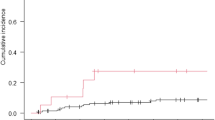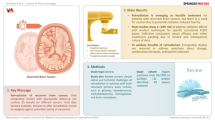Abstract
Background Cerebral radiation necrosis is a serious complication of radiation treatment for brain tumors. Therapeutic options include corticosteroids, anticoagulation and hyperbaric oxygen with limited efficacy. Bevacizumab, an antibody against VEGF had been reported to reduce edema in patients with suspected radiation necrosis. We retrospectively reviewed 6 patients with biopsy proven cerebral radiation necrosis treated with bevacizumab between 2006 and 2008. Results Interval MRI follow-up demonstrated radiographic response in all patients with an average reduction of 79% for the post gadolinium studies and 49% for the FLAIR images. The initial partial radiographic response was noted for up to a mean follow-up time of 5.9 months (6 weeks to 18 months). Conclusion Bevacizumab appears to produce radiographic response and clinical benefits in the treatment of patients with cerebral radionecrosis.




Similar content being viewed by others
References
Giglio P, Gilbert MR (2003) Cerebral radiation necrosis. Neurology 9(4):180–188. doi:10.1097/01.nrl.0000080951.78533.c4
Cross N, Glantz M (2003) Neurologic complications of radiation therapy. Neurol Clin N Am 21(1):249–277
Gonzales J, Kumar AJ, Conrad CA, Levin VA (2007) Effect of bevacizumab on radiation necrosis of the brain. Int J Radiat Oncol Biol Phys 67(2):323–326. doi:10.1016/j.ijrobp.2006.10.010
Brandes A, Tosoni A, Spagnolli F, Frezza G, Leonardi M, Calbucci F, Franceschi E (2008) Disease progression after concomitant radiochemotherapy treatment: pitfalls in neurooncology. Neuro-oncol 10(3):361–367. doi:10.1215/15228517-2008-008
Ricci P, Karis J, Heiserman J, Fram EK, Bice AN, Drayer BP (1998) Differentiating recurrent tumor from radiation necrosis: time for re-evaluation of positron emission tomography? AJNR Am J Neuroradiol 19(3):407–413
McPherson C, Warnick R (2004) Results of contemporary surgical management of radiation necrosis using frameless stereotaxis and intraoperative magnetic resonance imaging. J Neurooncol 68(1):41–47. doi:10.1023/B:NEON.0000024744.16031.e9
Chuba P, Aronin P, Bhambhani K, Eichenhorn M, Zamarano L, Cianci P, Mulbauer M, Porter AT, Fontanesi J (1997) Hyperbaric oxygen therapy for radiation induced brain injury in children. Cancer 80(10):2005–2012. doi:10.1002/(SICI)1097-0142(19971115)80:10<2005::AID-CNCR19>3.0.CO;2-0
Leber KA, Eder HG, Kovac H, Anegg U, Pendl G (1998) Treatment of cerebral radionecrosis by hyperbaric oxygen therapy. Stereotact Funct Neurosurg 70(suppl 1):229–236. doi:10.1159/000056426
Glantz MJ, Burger PC, Friedman AH, Radtke RA, Massey EW, Schold SC Jr (1994) Treatment of radiation-induced nervous system injury with heparin and warfarin. Neurology 44(11):2020–2027
Macdonald DR, Cascino TL, Schold SC Jr, Cairncross JG (1990) Response criteria for phase II studies of supratentorial malignant glioma. J Clin Oncol 8:1277–1280
Corn BW, Yousem DM, Scott CB, Rotman M, Asbell SO, Nelson DF, Martin L, Curran WJ Jr (1994) White matter changes are correlated significantly with radiation dose Observations from a randomized dose-escalation trial for malignant glioma (Radiation Therapy Oncology Group 83-02). Cancer 74(10):2828–2835. doi:10.1002/1097-0142(19941115)74:10<2828::AID-CNCR2820741014>3.0.CO;2-K
Levin VA, Yung WK, Bruner J, Kyritsis A, Leeds N, Gleason MJ, Hess KR, Meyers CA, Ictech SA, Chang E, Maor MH (2002) Phase II study of accelerated fractionation radiation therapy with carboplatin followed by PCV chemotherapy for the treatment of anaplastic gliomas. Int J Radiat Oncol Biol Phys 53(1):58–66. doi:10.1016/S0360-3016(01)02819-X
Jain R, Scarpace L, Ellika S, Schultz LR, Rock JP, Rosenblum ML, Patel SC, Lee TY, Mikkelsen T (2007) First-pass perfusion computed tomography: initial experience in differentiating recurrent brain tumors from radiation effects and radiation necrosis. Neurosurgery 61(4):778–787
Ruben JD, Dally M, Bailey M, Smith R, McLean CA, Fedele P (2006) Cerebral radiation necrosis: incidence, outcomes, and risk factors with emphasis on radiation parameters and chemotherapy. Int J Radiat Oncol Biol Phys 65(2):499–508. doi:10.1016/j.ijrobp.2005.12.002
Peterson K, Clark HB, Hall WA, Truwit CL (1995) Multifocal enhancing magnetic resonance imaging lesions following cranial irradiation. Ann Neurol 38(2):237–244. doi:10.1002/ana.410380217
Glantz MJ, Choy H, Kearns CM, Cole BF, Mills P, Zuhowski EG, Saris S, Rhodes CH, Stopa E, Egorin MJ (1996) Phase I study of weekly outpatient paclitaxel and concurrent cranial irradiation in adults with astrocytomas. J Clin Oncol 14(2):600–609
Chamberlain MC, Glantz MJ, Chalmers L, Van Horn A, Sloan AE (2007) Early necrosis following concurrent Temodar and radiotherapy in patients with glioblastoma. J Neurooncol 82:81–83. doi:10.1007/s11060-006-9241-y
Kumar AJ, Leeds NE, Fuller GN, Van Tassel P, Maor MH, Sawaya RE, Levin VA (2000) Malignant gliomas: MR imaging spectrum of radiation therapy- and chemotherapy-induced necrosis of the brain after treatment. Radiology 217(2):377–384
Cheng KM, Chan CM, Fu YT, Ho LC, Cheung FC, Law CK (2001) Acute hemorrhage in late radiation necrosis of the temporal lobe: report of five cases and review of the literature. J Neurooncol 51(2):143–150. doi:10.1023/A:1010631112015
Kim JH, Chung YG, Kim CY, Kim HK, Lee HK (2004) Upregulation of VEGF and FGF2 in normal rat brain after experimental intraoperative radiation therapy. J Korean Med Sci 19(6):879–886
Li Y-Q, Ballinger JR, Nordal RA, Su ZF, Wong CS (2001) Hypoxia in radiation-induced blood-spinal cord barrier breakdown. Cancer Res 61:3348–3354
Author information
Authors and Affiliations
Corresponding author
Rights and permissions
About this article
Cite this article
Torcuator, R., Zuniga, R., Mohan, Y.S. et al. Initial experience with bevacizumab treatment for biopsy confirmed cerebral radiation necrosis. J Neurooncol 94, 63–68 (2009). https://doi.org/10.1007/s11060-009-9801-z
Received:
Accepted:
Published:
Issue Date:
DOI: https://doi.org/10.1007/s11060-009-9801-z




